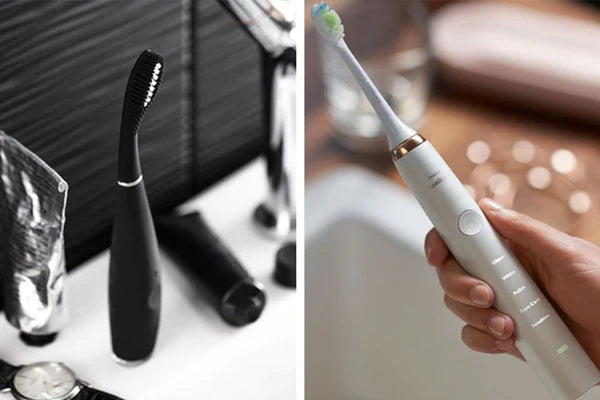The electric toothbrush has long since replaced the traditional manual toothbrush. In particular, the sonic toothbrush is becoming common in bathrooms.
Because it not only cleans more thoroughly, but is also more comfortable, more hygienic and easier to use. But how exactly does a sonic toothbrush work and what is the secret of its success?
What is a sonic toothbrush?
The sonic toothbrush is an electric toothbrush. It cleans teeth with extremely fast movements. These movements are made so fast that they are only perceived as vibrations when brushing the teeth.
Specifically, the head of the electric toothbrush must oscillate between 30,000 and 62,000 times per minute for the model to be called a sonic toothbrush.
Usually, sonic toothbrushes are powered by a built-in rechargeable battery. This lithium-ion battery is rechargeable and has a life of up to six weeks in the highest quality models.
The sonic toothbrush can also be easily transported without a charging station or taken with you on vacation. Battery operated sonic toothbrushes are also available.
These modern toothbrushes are often equipped with various features such as pressure control or various cleaning programs. Premium models usually have a Bluetooth function. Thus, the sonic toothbrush can be connected to the smartphone. The app provided by the manufacturer can be used to check the brushing progress or other controls.
Challenges are often offered to children to make brushing teeth an exciting and rewarding experience.
How does a sonic toothbrush work?
Sonic toothbrush technology is based on 30,000 to 62,000 lateral bristle oscillations per minute. The resulting vibrations provide an extremely effective cleaning effect.
Unlike a manual toothbrush, the brush head does not move up and down, but glides over the teeth. The bristles are so fine that they vibrate a hundred times faster than a manual toothbrush.
The sonic toothbrush achieves its extremely high frequency by working with a sound transducer instead of an electric motor. This generates the vibrations, which are then transmitted directly to the brush head.
The teeth are then cleaned by moving the brush head with the sound. The generated sound waves and the associated fluid flow in turn offer the advantage that even hard-to-reach interdental spaces can be cleaned thoroughly.
In addition, the sonic toothbrush does not require any pressure when brushing. Due to the high-frequency up and down movement, no effort is required.Some toothbrushes have 3 modes of sonic vibrations: soft, normal or intensive. This is the case with the Y-Brush toothbrush, which also allows you to brush your teeth in 10 seconds.
The difference between sonic and ultrasonic toothbrushes
Sonic toothbrushes have as their main specificity a brush head that vibrates at high speed. This means that you will experience a completely different brushing sensation than with oscillation-based models. On the other hand, sonic models do not emit ultrasound. The main characteristic is that the brush head moves at high speed and the rapid movement it makes is the source of the sound that is emitted. Ultrasonic toothbrushes, on the other hand, use both a vibratory sound movement of the brush head and ultrasound in the frequency range of 1.0 to 3.0 MHz. Ultrasound not only cleans the teeth well, but also reduces gum bleeding and effectively removes bacterial plaque.
What are the benefits of the sonic toothbrush function?
The vibrations of the sonic toothbrush clean both the surface and sides of the teeth thoroughly and gently. This type of device ensures that even hard-to-reach interdental spaces are cleaned of plaque and bacteria.
Since minimal pressure is required, the gums are not irritated. This significantly reduces the risk of gum inflammation.
This type of brush also offers greater comfort, as the toothbrush only has to be held against the teeth and no rubbing movements are required. This is particularly useful for people with mobility problems or for children.
Sonic toothbrushes: for whom?
Overall, sonic toothbrushes are designed to be used by a large majority of people, even those with oral-dental problems.
For people with sensitive gums :
Many sonic toothbrushes have special sensitive modes and brush very gently.
But it's best to talk to your dentist first, who can better assess the condition of your teeth and advise you on the right type of brush for your needs.
For people with fillings or implants:
Implants also benefit from a more thorough cleaning with sonic toothbrushes.
It is best to use a regular manual toothbrush immediately after intensive dental treatment and then switch to a sonic toothbrush afterwards.
For people with braces:
Be aware that there are even special accessories for each type of braces.
The brush head doesn't move and is ideal for these appliances because it can't get caught in the metal wires. Unfortunately, real sonic toothbrushes of this type are more expensive to buy than the more traditional ones.
In a nutshell,
Sonic toothbrushes are particularly effective and adapted to each type of dental problem. Most manufacturers recommend sonic toothbrushes from the age of 12. However, there are also specific models for children from 4 to 6 years old.



